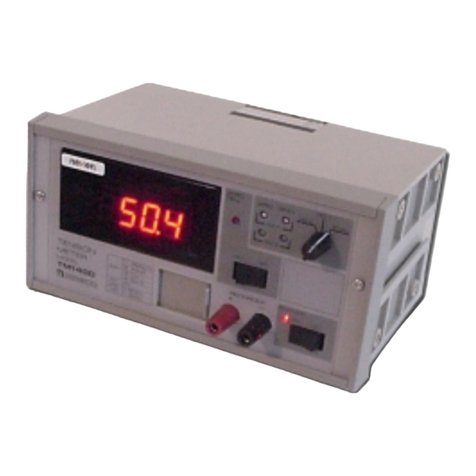
1FORM NO. L-20185-B-0501
INTRODUCTION
Read this manual carefully, making full use of its explanations and instructions. The “Know How” of safe, continuous,
trouble-free operation depends on the degree of your understanding of the system and your willingness to keep all
components in proper operating condition. Pay particular attention to all NOTES, CAUTIONS, and WARNINGS to avoid
the risk of personal injury or property damage. It is important to understand that these NOTES, CAUTIONS, and
WARNINGS are not exhaustive. Nexen cannot possibly know or evaluate all conceivable methods in which service may
be performed, or the possible hazardous consequences of each method. Accordingly, anyone who uses a procedure
that is not recommended by Nexen must first satisfy themselves that neither their safety or the safety of the product will
be jeopardized by the service method selected.
THEORY OF OPERATION
Nexen’s TM140A Tension Meter measures, displays, and
provides proportional output signals, based upon tension
generated in a continuous strip process. The TM140A
provides excitation for two LDVT based MB Series
tension sensing load cells or one of two Nexen strain
gage sensors (type S or CFL). The load cells measure
web tension and provide a proportional low voltage
output signal.
The TM140A amplifies the signals from the two load cells
separately (See Figure 1) and feeds the Tension Indicator
and several output circuits with the resultant amplified
signals. The Read Out Selector Switch determines which
of the buffered signals are displayed on the Tension
Indicator and Recorder Terminals. The Tension Indicator
has a dual-range scale. The high-range, low-range
control is made through the Range Switch, which also
controls output at the Recorder Terminals.
FIGURE 1
Buffered signals are also present at Terminals 26, 27,
and 28 located on the back panel of the TM140A. These
three terminals are not affected by the position of the
Read Out Selector Switch or the Range Switch. The
total tension signal is also presented as a 4-20 mA signal
at Terminals 10 and 11, and as a 0-10VDC signal at
Terminals 29 and 30. These two signals are not buffered
or filtered.
A zero tension circuit is also provided. The zero tension
circuit closes a Normally Open (N.O.) relay when tension
drops to a low level, as would occur during a web break.
This circuit is controlled with a front panel switch and may
be disabled when running at extremely low tensions to
prevent nuisance tripping.
No. 2
Total
High
Low
Range
Switch
Terminal Block
Connections on
Back Panel
Read Out
Selector
Switch
Tension
Indicator
Recorder
Terminals
MB #1
No. 1
Amp
MB #2
No. 2
Amp
Buffer
Buffer
Buffer
+
No. 1
Amp
Amp
0-10VDC
4-20 mA




























